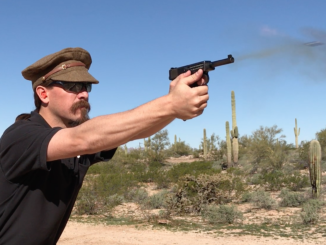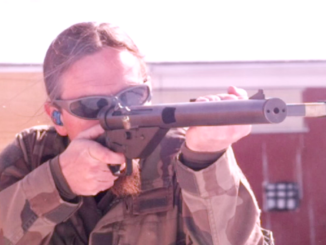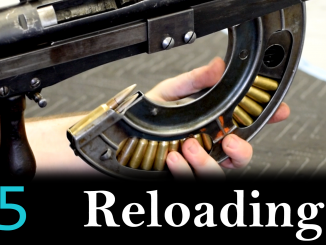Hiram Maxim’s hired shop supervisor was a man named Louis Silverman. He was a skilled engineer, who was treated rather poorly by Maxim, and whose contributions were systematically understated. One of the most interesting projects Silverman partook in was the design of a self-loading pistol in 1896. A patent was taken out in the names of both he and Maxim, but the lack of discussion by in Maxim’s papers makes it clear that the idea was Silverman’s.
The pistol was simple and efficient; easy to make and quite forward-looking. However, it was crippled by the choice to use cartridges too powerful for its simple blowback operation. Today we are taking a look at the particular massive example made in .455 Webley. The other two regular Maxim-Silverman pistols are rather large, and this one is a true behemoth…
For more information, see my full article on the design, and my video on the surviving 7.65mm Borchardt example:




Now I am wondering if any of Maxim-Silverman designs inspired Adler automatic pistol
https://www.rockislandauction.com/detail/68/3296/adler-semiautomatic-pistol-725-mm
https://www.rockislandauction.com/detail/70/3492/adler-semiautomatic-pistol-55-mm
? Adler was smaller but grip angle and bare barrel are common for both.
The low parts count and seemingly modest manufacturing requirements do make it look like a good system for a fixed-barrel .32 ACP or .380 ACP pistol.
“look like a good system for a fixed-barrel .32 ACP or .380 ACP pistol.”
Note that due to layout used it is rather not efficient lengthwise (length of rifled part of barrel to overall length ratio) when compared to automatic pistol where forward-most point of moving parts is more forward than backward-most part of barrel, thus requiring shorter barrel or longer overall length in comparison to for example Browning No. 1
https://www.militaryfactory.com/smallarms/detail.asp?smallarms_id=640
That’s not a pistol, it’s field artillery!
Where’s the wheeled carriage when you need it?
I am wondering if 8 mm version was first then .455 or it was another way around?
Striker pistols have a weakness of providing consisteny of impact and cocking element contacts by cause of carrying of each at separate locations as one in the bolt and one in the receiver… This pistols seems deleted this weakness containing the both unit in the same part… In the bolt… Hats off…
This is an entirely extremely interesting pistol.
The rollback dampening system alone is worth something!
A shot from a partial rollout, with a two-stage braking of the mobile group.
Maxim should have been more attentive to Silverman.
Indeed, outstanding mechanics.
Although the entire pistol is more of a test demonstration model than a pistol.
“(…)skilled engineer, who was treated rather poorly by Maxim(…)”
I am looking at drawing of patent, see 3rd image from top:
http://historypistols.ru/blog/pistolety-pod-unitarnyj-patron-avtomaticheskie/eksperimentalnyj-pistolet-silverman-maksim-obrazca-1896-goda-m1896-silverman-maxim-pistol/
which is described as
MAXIM & another’s COMPLETE SPECIFICATION
was this normal in 1890s British patent, when having more more than 1 inventor or it is emanation of being treated poorly?
Disconnect and sear system of this gun seems, first borrowed by Elbert Searle for 1906 Savage and later by J.M.Browning and Saive for 1927 and 1935 GP Pistols… IMHO…
Wildey, Desert Eagle… Tsssss!
I’m seeing the 44 Automags great great grandpa.
The Auto-Mag combined the breechlock of the Schwarzlose Standart with the layout of the Grant-Hammond.
There was a .380 automatic briefly marketed in the 1970s that looked distinctly like the Silverman-Maxim, but was much smaller. I remember seeing it advertised in G&A around 1975.
cheers
eon
Sleek. Zap… Space gun.
Put a folding stock on it and you would have one of those mid 1980’s pistol calibre carabines like the G-/-/ which name I cant remember
Gonscz?
Something on back of my mind is telling me this was intended as a PRANK.
Ze Germans have sense of humor too, you know 🙂
Daweo – My dad wad a chemical enginer and had about two dozen patents, but since they were done on “company time”, by terms of his employment contract, they belonged his employer-a not uncommon practice. Presumably the firm paid the patent attorney and other fees, so maybe the patent application was in its name and not that of its employees.
As far as size goes, remember that in 1890, Horse Cavalry was still regarded as n important arm (Leftenant Churchill would charge at Omdurman about a decade later, so Naploeonic tactics were still used). One thing the cavalry used were “horse pistols”, pistols so big that their holsters were mounted forward of the saddle.
“Light cavalry of the early modern period were equipped with a sabre and specialised horse pistols, carried in saddle holsters.[citation needed] These large calibre single shot handguns, also known as holster pistols, horsemen’s pistols, cavalry pistols or musket calibre pistols, saw extensive use among the British and French armies during the Napoleonic War”
Austria had a large cavalry arm (specifically in the Honved – “hussar is Hungarian for soldier) so that might that explain the size.
https://en.wikipedia.org/wiki/Royal_Hungarian_Honv%C3%A9d
Good to read your history quip, it is sign of quest for knowledge – a positive trait.
I would add that before Hungarian emancipation the A-H army command was in Austrian hands. Most remarkable figure of the time was Duke Josef Radecky (original Czech spelling)https://en.wikipedia.org/wiki/Joseph_Radetzky_von_Radetz
Oh, the questions I have!
Did Andreas Schwarzlose see this gun or the patent? Note the similarity between these guns and S’s 1898 Standardt — the dual-purpose striker/recoil spring, the general layout, the tubular structure, even that strange uh, phallic shape of the striker nose. (Undoubtedly chosen to add weight to the bolt.)
Did Georg Luger see this gun or the patent? Note the fine grip angle and the, uh, shape of the striker? Did Luger think of Schwarzlose or Silverman when re-designing the Borchardt into the Parabellum?
Why did fate make it that Bill Ruger copied the Nambu and not this design for his Standard .22? A natural pointer, easy to construct, AND EASY TO DISASSEMBLE!
And I know why nobody will copy this now in .22 — development costs, when the world is flooded with Rugers, especially the more convenient Mark IV.
Thanks again to Mr. M. for showing us these remarkable designs.
I would modify; Pritchard bayonet attachment and extend the mag wells rear lower than the mag, cut at an angle / = sharpen the left of the / which will protude, 2cm or so of blade.
Germans; Passchendaele, empty the mag then stab and bludgeon.
It’s a fair size.
“Lovely place Germany, just meant after market mods circa 1914”
Or so; sort of a blade… That was meant to read. Chisel like. Like these new torches. In the face.
Is that grip angle for mechanical reasons, or a low bore axis type thing; just watched that Danish Scho… Etc, video; that 1916 version had a similar angle.
Prefered it in .577 Bland-Pryse personally “We have the biggest Navy you dastardley Hun! Take that!” You accept your not going to be a military hedgemon now don’t you… You are too late America is the thing. “Nein” Right, bludgeon. “Nein” stab. RELOAD.
“The coming of a bi-polar world” Quite literally, ha.
Bang Bang, Maxim’s Silver Hasmmer
Came down upon his head
I wonder if, when brand new and fit correctly, if that leather buffer ring also provides a small amount of sealing to partly act as a gas spring and slow the bolt?
17 parts?! You have my attention.
In a caliber, like, say, 9×18 Makarov or 9×17 Browning court/.380 acp? Might be viable at least as a set of plans for a home build, no?